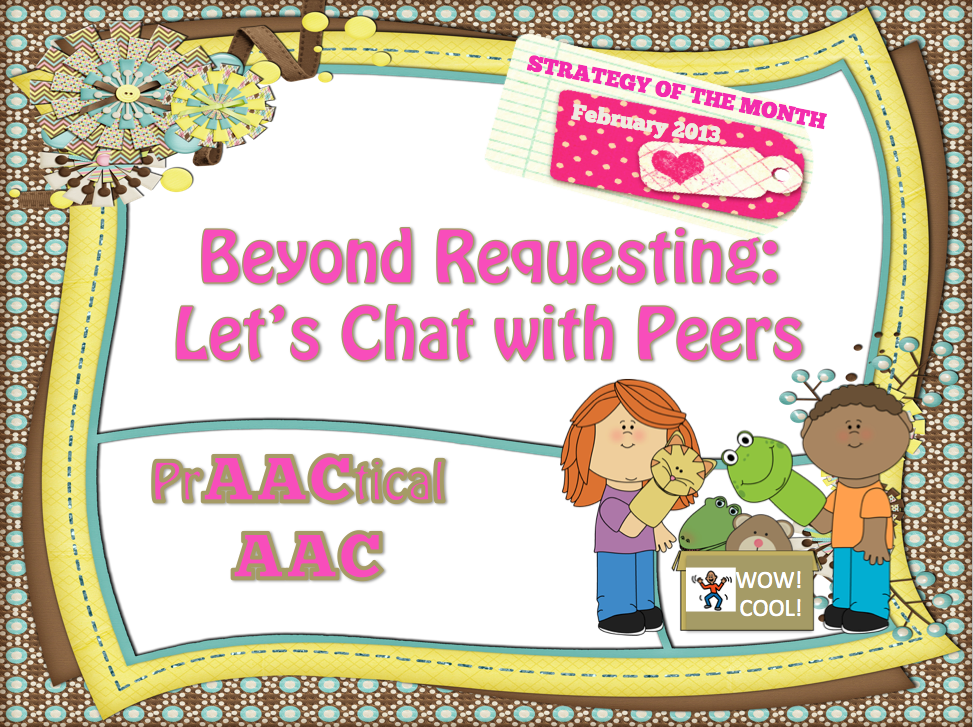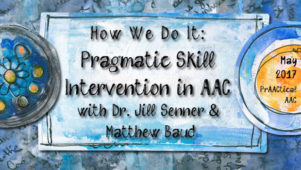Beyond Requesting: Let’s Chat with Peers

As we wrap up the February Strategy of the Month, we need to add strategies for helping AAC users talk/chat with peers. For some learners, it is more about providing access and opportunity while for others, it is more about providing a platform for the social awareness and exchange. However, for all learners who need assistance in ‘chatting’, there are many goals and strategies that will help.
Setting the Foundation for Social Exchanges with Peers
- Provide frequent opportunities for peers to communicate with each other- Build in many opportunities within all (or almost all) activities for generic small talk, gossiping, & chatting.
- Create activities that have’ built in’ communication with peers- develop activities that require communication with peers to make the activity work. Instead of having all communication directed at the adults/facilitators in the room, have the learners talk to peers to take steps in the activity. Set up joint action routines that require learners to take a role that is dependent on what a peer says or does.
- Use activities that have predictable structure- By developing activities with predictable and familiar structure, learners will know when and what to do when it is their turn. When peer-to-peer communication is part of the structure, all learners can be successful over time.
- Provide access to appropriate core word and small talk vocabulary– Make sure learners have quick access to appropriate vocabulary that allows for initiation and continuation of small talk.
Strategies for Teaching
This is where some of the strategies remain the same as with any language teaching, as well as some new strategies help specifically with social exchanges for peers.
- Aided Language Input
- Think Aloud Strategy
- Wait & Signal
- Visual Supports- use visual supports to delineate turns, roles, jobs, and times (gossip time, chat time, etc.). Make the social exchanges clear through visual supports if appropriate.
- Gestural Prompting- use a gesture directed at AAC display or learner to show it is their turn as this is often enough of a prompt and does not put the adult in the exchange the way a verbal prompt might.
- Peer Modeling/Teaching- Check out Come Play with Me by Howard Goldstein & Kathy Thiemann-Bourque (January 2012) for research support and ideas for teaching peers to facilitate social exchanges.
- Metalinguistic Feedback & Vocabulary- talk about small talk, gossiping, chatting. Give feedback specific to seeing and hearing these types of communication exchanges. The more we point out when we see ourselves and others engage in the ‘target behaviors’, the more we make the goals transparent in a meaningful way to learners.
Activities/Goals/Rationales/Vocabulary
| Activity | Possible Goals | Setting Foundation | Specific Targets |
| Show & Tell | To share information with peers To ask questions from peers To comment to peers |
Predictable structure Daily opportunity (may even have 2 show & tell’s per day) Peers do the commenting and questioning |
“cool”, “wow”, “tell us more”, “what else about it”, “where did you get it”, etc |
| Group Art Project | To comment to peers | Frequent opportunities to comment within the activity | “pretty”, “that’s beautiful”, ‘my favorite”, “what do you think”, “awesome” |
| Group Cooking Snack Time Lunch Time |
To share information with peers (on steps of recipe) To comment to peers |
Predictable structure Frequent daily opportunities |
“delicious”, “not good”, “oh no”, |
| Chat Clubs Chat Times Gossip Times |
To participate small talk with peers To complete ___ social communication exchanges with peers |
Frequent opportunities especially if at each transition between classroom/session activities calls for a ‘chat’ or ‘gossip’ time’ Adult facilitator could release ‘gossip’ right before activity ends. |
“hey”, “oh no”, “look”,”funny”, “again”, “I know” |
| Class Surveys Class Votes |
To ask questions of peers To comment |
Predictable structure Frequent opportunities Built in peer communication |
“what do you think”, “hi”, “no way”, |
| Class Jobs (i.e., attendance, news, plant watering, class commenter/ reinforcer etc.) |
To provide information to peers To comment to peers |
Predictable structure Frequent opportunties |
“hey”, “cool”, “love it”, “goes there”, “really”, “that’s all” |
Social communication makes up more than 50% of our communication. For AAC learners, we need to provide opportunities, access, and specific teaching to facilitate range and complexity of social interaction and communication skills.
Further resources on social exchanges and AAC small talk vocabulary- Let’s Get Social & AAC Apps for Small Talk– Thanks as always Jane Farrall
Filed under: Strategy of the Month
Tagged With: Social Language
This post was written by Robin Parker






4 Comments
You guys are simply awesome! I love love love this site. I think so many SLPs are afraid of AAC only because they aren’t comfortable doing it! But y’all lay it out so clearly that I have forwarded countless articles on to SPED teachers and SLPs alike. I just wanted to finally take a second to tell you that! Thanks for all of the sample goals, examples, ideas etc. Keep it coming!
Thank you so much for taking the time to write. A goal/intent of ours has always been to share information about AAC so that more SLP’s, teachers, parents, etc. feel comfortable providing communication instruction. Your comment helps make us feel like we are moving in the right direction. And this ultimately will help more children and adults learn to communicate successfully which is another main goal of our blogging. So after a long difficult day, thank you very much!
Robin,
I couldn’t agree with Jill more. You and Carole both share such great resources that I refer people to constantly – thank YOU!!!!
I was just talking with a group of teachers about this topic yesterday so it’s perfect timing to do a follow up email pointing them to this post 🙂
Thanks!
Jane
It is truly a nice and helpful piece of information. I am glad that yoou shared thiss helpful info with
us. Please stay us informed like this. Thank you for sharing.